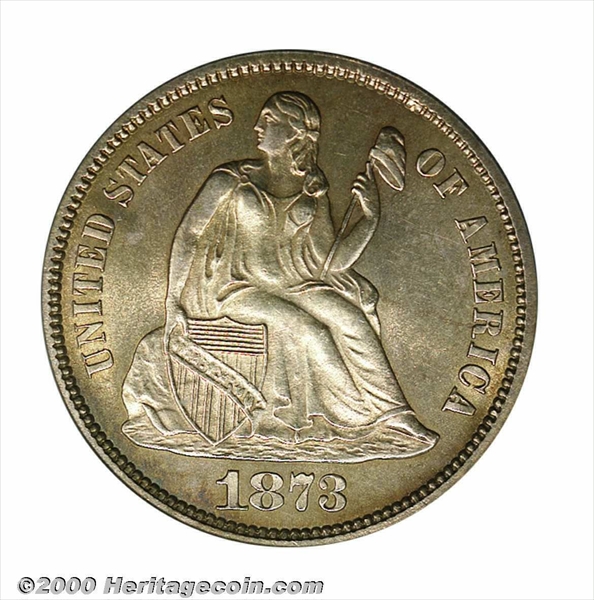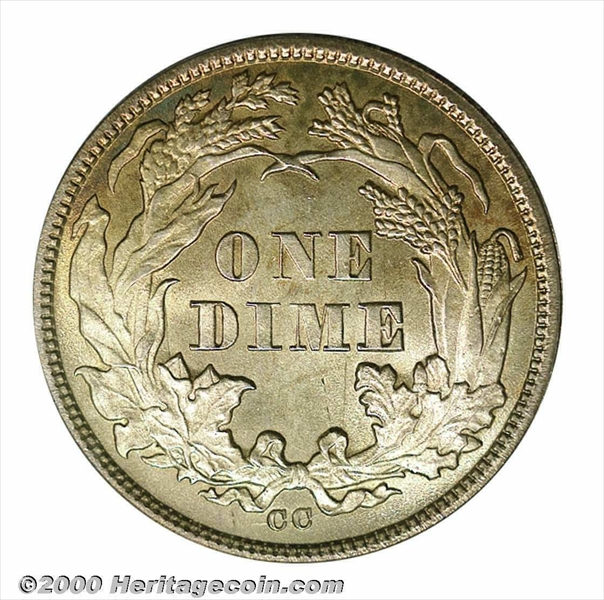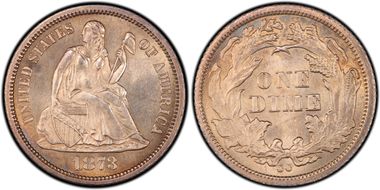1873-CC 10C No Arrows MS64 认证号-22104, PCGS号4661
拥有者评论
专家评论
David Hall
This is one of the great unheralded rarities of U.S. numismatics. The following statement sums it up for me. Louis Eliasberg put together the only complete collection of U.S. coins ever assembled. The last coin he aquired for his collection was the 1873-CC no arrows dime! Check out Dave Bowers great write-up of this coin from his 1996 Eliasberg auction catalog below.Q. David Bowers
As the presently offered 1873-CC Without Arrows Liberty Seated dime is a superbly satiny gem and shows no evidence of circulation, it seems likely that it was reserved for inspection by the Assay Commission, which met in Philadelphia on Wednesday, February 11, 1874, to review the prior year's gold and silver production from all the mints. Parcels of coins from the various mints were opened, and random representative pieces were selected by Assay Commission members and were destructively tested in the Mint laboratory for weight and precious metal content.Only a few coins were actually tested; most were later melted or placed into circulation. Under this scenario, a numismatist-quite possibly a member of the Mint staff or perhaps the Mint Cabinet curator-asked for and received this untested coin for the face value at the time, simply by exchanging another dime for it. The coin was retained at the Mint and kept with care.
In 1909 John W. Haseltine and Stephen K Nagy were prominent dealers on the Philadelphia scene and had very close connections to the Mint. Many rarities-some of incredible importance-were marketed though Haseltine and Nagy. In 1907-1908 they introduced the 1884 and 1885 trade dollars to the numismatic community, these having remained for many years as part of Proof sets William Idler had obtained from the Mint in the year of issue. In 1909 Haseltine and Nagy sold for the previously unheard of level of $10,000 each, two different varieties of 1877 $50 "half union" pattern coins struck in gold. The existence of these was hitherto unknown.
The buyer of the two glittering Proofs was William H. Woodin, a leading industrialist (who years later in the early 1930s became President Franklin D. Roosevelt's secretary of the Treasury). Woodin was a numismatic scholar par excellence, and possessed a fine cabinet. A furor arose, and it was said that the pair of $50 gold patterns never should have left the Mint. The two pieces were returned to the Mint by exchange, in which "several crates" of coins-thousands totally, primarily patterns, but possibly including some other issues as well-were given to Haseltine and Nagy by Mint officials.
What a treasure trove this was! This hoard of patterns was utilized by Edgar H Adams, leading numismatic researcher of his day, to compile a book which appeared in 1913 with Adams' and Woodin's names on the title page, "United States Pattern, Trial, and Experimental Pieces."
Apparently, the 1873-CC Without Arrows Liberty Seated dime was included in this transfer, for it was soon in the Woodin Collection. Woodin-who at the time also owned the unique 1870-S $3 gold piece-realized the 1873-CC Without Arrows dime was rare, but how rare was not appreciated until many years later. As noted, in 1914 the 1873-CC Without Arrows dime was exhibited by Woodin at the American Numismatic Society.
On May 19-21, 1915, Wayte Raymond catalogued the "Collection of a Prominent American," which comprised consignments from Woodin and H.O.Granberg (of Oshkosh, Wisconsin). The successful bidder for the 1873-CC Without Arrows dime at the sale was Rudolph ("Rud") Kohler, a New York numismatist.
From that point the prize dime went into private hands, apparently including into those of Charles M. Williams, a Cincimmati businessman. Many of the Williams Collection gems were auctioned by the Numismatic Gallery (Abe Kosoff and Abner Kreisberg) in the Adolphe Menjou Collection (cover title of the catalog) sale on June 15, 1950. Williams, a reticent collector, shunned numismatic publicity; his collection, still unheralded today, included a 1804 Class I ("original") silver dollar.
When cataloging the Menjou Collection, Abe Kosoff realized the 1873-CC Without Arrows dime was important, but the numismatic community did not realize that it was unique. None of the scholars of the era had studied it, and it had not appeared in sales of leading collections. Thus it had not been researched by catalogers. The more he contemplated the coin, the rarer he realized it was.
The story of Abe Kosoff and the Menjou Collection is told in Chapter 4 of the book, "Louis E Eliasberg, Sr.: King of Coins," as are the details of the scenario when this coin came up for bidding competition. The buyer of the unique 1873-CC Without Arrows dime was James Kelly of Dayton, Ohio, a dealer who one time also handled three of the five known 1913 Lberty Head nickels, and his partner in the purchase was Sol Kaplan professional numismatist from Cincinnati.
On November 7. 1950, Kelly sold the coin to Louis E. Eliasberg, Sr., thus completing his cabinet.
The unique 1873-CC Without Arrows dime in the Eliasberg Collection is truly memorable, not only for being the only known example of its issue, but for being the rarest Carson City Mint coin, for being a superb gem, and being the most elusive of all coins in Louis Eliasberg's quest for completion.
Ron Guth
Significant examples:
The following narrative comes from Heritage Numismatic Auctions, Inc.'s April 1999 Central States Signature Sale: "This is the only example known of the 1873-CC Dime with no arrows on either side of the date. The exact circumstances surrounding the production of this issue are unknown, but Mint records indicate that 12,400 pieces were struck. Presumably all were melted and converted to Arrows Dimes with the exception of a few saved for assay purposes. The theory is that this single coin was saved from the destructive testing done by the Assay Commission. Probably one of the assay members was able to trade it for face value at the time by merely exchanging another Dime for it. It was apparently kept in the Mint collection for several decades where it was well preserved, not appearing again for 36 years.
"In 1909, Philadelphia dealers John Haseltine and Stephen Nagy sold a pair of 1877 gold Half Union patterns for the unprecedented price of $10,000 each. The buyer was future Secretary of the Treasury, William Woodin. A short paragraph from the Bower's Eliasberg catalog describes what happened next: "A furor arose, and it was said that the pair of $50 gold patterns never should have left the Mint. The two pieces were returned to the Mint by exchange, in which "several crates" of coins--thousands totally, primarily patterns, but possibly including some other issues as well--were given to Haseltine and Nagy by Mint officials. What a treasure trove this was!"
"The No Arrows '73-CC was apparently a part of this momentous trade and Woodin was the first owner of record of this important rarity. The coin was exhibited at the 1914 ANS Exhibit in the Spring of that year, and over the next several decades passed through the collections of several noted collectors. Charles Williams owned the coin and consigned it along with several other notable rarities (including a Class I 1804 Dollar) to the auction of Adolph Menjou's collection. Kosoff (who cataloged the sale) knew the coin was rare, but did not have a full appreciation of its true status as a unique item. Apparently dealer James Kelly had a more complete appreciation of its rarity, as did Louis Eliasberg. Both men wanted the coin and both were prepared to pay top dollar to buy it at the Menjou Sale. Eliasberg had flown in from Baltimore specifically to buy two coins: the 1853-O No Arrows Half Dollar and the 1873-CC No Arrows Dime. The Half Dollar he purchased for $890, but when it came time to sell the Dime the competition was much stronger. Years later Kosoff wrote that Jim Kelly "had hypnotized himself into a state of conviction that here was a coin that was worth any price. Opening at $1,100 Eliasberg stayed in the bidding until he was convinced that Kelly had no limit, and he allowed Kelly to purchase the piece for $3,650. Several weeks later, on November 7, Kelly and Sol Kaplan sold the Dime to Eliasberg as the final piece needed in his complete set of U.S. coinage.
"The coin remained in the Eliasberg Collection until sold by Bowers in May, 1996 for $550,000. The buyer from the Eliasberg Sale was noted collector Waldo Bolen. Bolen had already spent years assembling a collection of Dimes--a complete set of every Dime produced by the U.S. Mint, except for the unique 1873-CC No Arrows. He then sold his Dimes at auction. When the 1873-CC finally came on the market, he purchased it, just for the pleasure of knowing that he had owned every U.S. Dime. Bolen became so enamored of the issue that he decided to build a complete 11-piece 1873-CC set around the linchpin No Arrows Dime.
"The coin itself is sharply struck. Its satiny luster is slightly subdued and both sides are draped in an even layering of golden-brown patina. Die polishing lines are noted on the figure of Liberty, and a die crack runs prominently through the mintmark, this same reverse die also being used to strike the 1873-CC With Arrows Dimes as well as the 1874-CC pieces. The only abrasions of consequence are a pair of marks in the lower reverse field below the M in DIME.
"In our 23 years in the auction business we cannot think of another, more prestigious coin that has passed through our hands. Added to the obvious importance of the coin's unique stature is the allure of the Carson City mintmark, with coins from this Mint being among the most romantic, storied, and highly collected in all of U.S. numismatics."
Sources and/or recommended reading:
"1873-CC No Arrows Dime Discovery" by Rusty Goe, E-Sylum: Volume 6, Number 24, June 15, 2003
"Unique 1873-CC dime sells" by William T. Gibbs, COIN WORLD, pages 3 and 80
P. Scott Rubin
The 1873-CC No Arrows dime is a unique coin with a storied past with the coin passing thru the hands of some of the biggest coin collectors of the twentieth century, starting with H.O. Granberg, then Waldo Newcomer, Charles M. Williams and Louis Eliasberg, Sr.The story has been told for years that the 1873-CC No Arrows Dime was part of a deal between John Haseltine and Steven Nagy with William Woodin to repay Woodin for his returning the two gold fifty dollar pattern gold pieces to U.S. government which he had purchased for an enormous sum in the early twentieth century from Haseltine and Nagy. The story goes on to say that the large group of patterns Woodin also received as part of this same transaction was all supplied by the U.S. government to recover the two gold 1877 Fifty Dollar coins. The assumption being that the 1873-CC No Arrows Dime was also supplied by the government. Yet no documentation is known to show that Woodin ever owned the coin.
There is numismatic evidence that offers a different source for the dime. In May of 1878 Dealer Edward Cogan offered the collection of John Swan Randall, who is best remembered for owning what is still referred to as the Randall Hoard of 1810’s and 1820’s high grade large cents. What is lost in the numismatic memory about this collection is that it also contained a significant group of Carson City minted silver coinage. This sale was the first of only two times in numismatic history that 1873-CC No Arrows Dime and Quarter appeared in one sale. The second time was not the Eliasberg collection sale since the two Eliasberg coins were sold in two separate sales in different years, it was the April, 1999 Heritage Sale of the Waldo Bolen collection coins.
Included in the 1878 Cogan Randall sale were the following CC coinage:
Dollars – 1870, 1871, 1872, 1873 Trade Dollar, 1874(2 coins), 1875, 1876 and 1877
Half Dollars – 1870(2 coins), 1871, 1872, 1873 No Arrows(2 coins), 1873 With Arrows, 1874, 1875, 1876, and 1877(2 coins)
Quarters – 1871, 1872, 1873 No Arrows, 1875, 1876 and 1877
Dimes – 1871, 1872, 1873 No Arrows, 1874, 1875, 1877(2 coins)
稀有性和存量估计 了解更多
| 所有评级 | 1 |
| 60或以上 | 1 |
| 65或以上 | 1 |
| 所有评级 | R-10.0 |
| 60或以上 | R-10.0 |
| 65或以上 | R-10.0 |
| 所有评级 | 1 / 67 |
| 60或以上 | 1 / 67 |
| 65或以上 | 1 / 67 TIE |
| 所有评级 | 1 / 122 |
| 60或以上 | 1 / 122 |
| 65或以上 | 1 / 122 TIE |






















